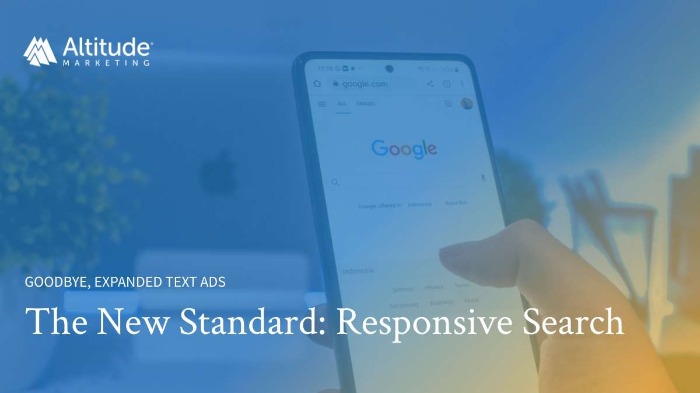Google’s expanded text ads are going away in June 2022. After that, only responsive search ads will be available. In this post, we look into why Google is making this change – and how it benefits everyone.
June 30, 2022, is the last day anyone can create or edit Google expanded text ads. From that point on, there won’t be any support for them, meaning advertisers will only be able to pause, resume and delete their existing expanded text campaigns and ad groups.
While this moment may be bittersweet for some, the good news is that responsive search ads will become the new standard for search campaigns. Google is strongly encouraging advertisers to switch due to the various benefits these ads bring. But before we get into that, let’s review the basics of expanded text ads and responsive search ads.
What Are Expanded Text Ads?
Expanded text ads include three headlines and two descriptions. Each headline can have 30 characters, while descriptions can contain 90 characters.
Expanded text ads are static, meaning they don’t change once you input the text into Google Ad Manager. The order of the headlines and descriptions stays the same every time for each ad. What you see is what you get.

What Are Responsive Search Ads?
Responsive search ads also include three headlines and two descriptions … as they’re shown to a user.
Unlike expanded text ads, Google’s algorithm automatically generates responsive search ads by focusing on the key phrases and putting them in sequential orders that make sense to the users. As a result, all the advertiser has to do is write up to 15 headlines and four descriptions for a single responsive search ad. From there, Google automatically pulls three headlines and two descriptions to create an ad.
Advertisers can lock certain headlines into preferred positions so that they always show up in certain spots. For example, if you want to ensure your company name appears in every ad, you can lock it into place.
Google tests these responsive search ads against each other to determine which ones perform better based on the number of clicks. High-performing ads have a better chance of showing up in the search results because they benefit everyone: the user, the advertiser and Google.
How Responsive Search Ads Benefit Everyone
Users
Users want Google to connect them to the content they’re looking for faster. But this can be difficult when 15% of daily search queries are new searches that Google has never seen before.
To provide a better user experience, Google automatically generates responsive search ads. This way, users can get relevant ads that they’re more likely to click.
Advertisers
Advertisers may be affected the most by Google’s sunsetting of expanded text ads, but they can also reap the most benefits because they save a lot of time and money in search advertising.
Save Time
As we mentioned earlier, responsive search ads only require 15 headlines and four descriptions for an ad group. If you ask any digital marketer, they’ll tell you that’s a considerable difference from extended text ads, which often require them to fill Excel spreadsheets with unique headlines and descriptions for dozens of ad groups.
Responsive search ads also eliminate the need for manually setting up tests. Instead, Google handles all the ad testing automatically, which frees up time for other tasks. Plus, advertisers can rest easy knowing that Google will put their best ads out there, showing the most relevant combinations to current and potential customers.
Save Money
All Google ads have a Quality Score that’s on a scale from 1-10. A higher Quality Score indicates your ad is more relevant and valuable to the user for that keyword than competitor ads.
A better Quality Score also means the ad costs less to run. A responsive search ad aims to:
- Achieve a high Quality Score
- Compete in more auctions
- Match more queries
When this happens, the ad’s performance improves, which saves the advertiser money.
Google benefits when users enjoy an outstanding search experience and advertisers get more clicks on their ads. However, for that to occur, Google needs to ensure users get relevant ads.
That’s why Google relies on its algorithm–which handles about 5.6 billion searches per day–to piece together relevant responsive search ads that users will click. In the end, users and advertisers are happy, and Google makes money.
tl;dr
Google is saying goodbye to expanded text ads. While it may be disappointing for some, it’s a necessary step forward as users’ search needs continue to evolve.
The good news is that responsive search ads are here to stay, which ultimately benefits everyone. Users get better ads, advertisers get more clicks, and Google remains the top search engine in the world.



